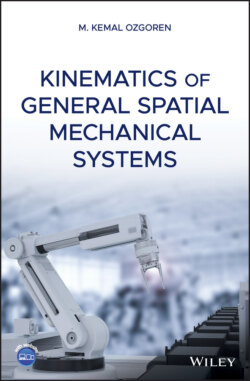Читать книгу Kinematics of General Spatial Mechanical Systems - M. Kemal Ozgoren - Страница 65
3.8 Expression of a Transformation Matrix in Terms of Euler Angles 3.8.1 General Definition of Euler Angles
ОглавлениеThe Euler angles are named after the Swiss mathematician Leonhard Euler (1707–1783). With a modification of what Euler originally introduced, the definition of the Euler angles was later generalized so that they consist of three rotation angles (φ1, φ2, φ3) about three specified rotation axes. The three axes must be specified so that they are neither coplanar nor successively parallel or coincident. Thus, the Euler angles constitute a set of three independent parameters for the transformation matrix . When a set of Euler angles is used, the reference frame is obtained by rotating the reference frame through the following sequence of three rotations.
(3.89)
In Description (3.89), and are the intermediate frames on the way from the initial frame to the final or terminal frame . As for the unit vectors , , and , they represent the specified rotation axes. They may be specified arbitrarily as desired in the generalized definition of the Euler angles, whereas they are specified as , , and in the original definition of the Euler angles.
Although , , and may be specified arbitrarily in general, in almost all the practical cases, each of them is specified as a selected basis vector of a selected reference frame. Thus, different Euler angle sequences arise depending on the selected reference frames and their selected basis vectors. All such Euler angle sequences are grouped into two main categories, which are designated as IFB and RFB sequences. These sequences are described and explained below.
